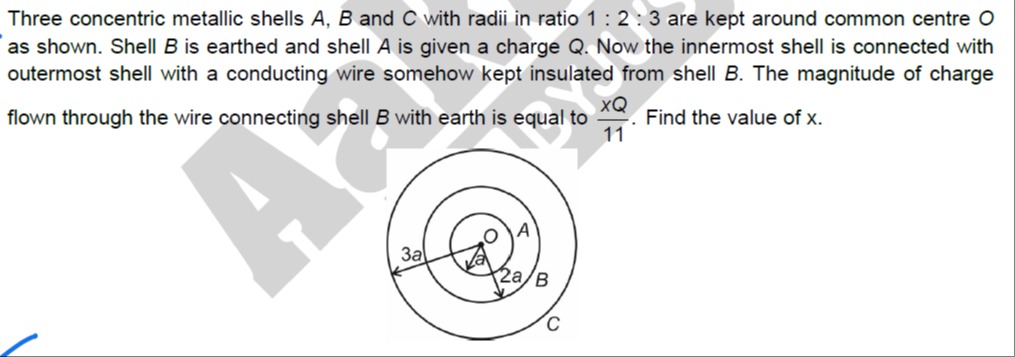Question
Question: Three concentric metallic shells A, B and C with radii in ratio 1 : 2 : 3 are kept around common cen...
Three concentric metallic shells A, B and C with radii in ratio 1 : 2 : 3 are kept around common centre O as shown. Shell B is earthed and shell A is given a charge Q. Now the innermost shell is connected with outermost shell with a conducting wire somehow kept insulated from shell B. The magnitude of charge flown through the wire connecting shell B with earth is equal to 11xQ. Find the value of x.

3
Solution
The radii of the three concentric metallic shells A, B, and C are RA=a, RB=2a, and RC=3a.
Initially, shell B is earthed, and shell A is given a charge Q. Shell C is initially uncharged.
In the initial state, let the charges on A, B, and C be QA=Q, QB, and QC=0.
Since shell B is earthed, its potential VB=0.
The potential at r=RB=2a is VB=RBkQA+RBkQB+RCkQC=2akQ+2akQB+3ak(0)=0.
This gives 2aQ+2aQB=0, so QB=−Q.
The initial charges are QA=Q, QB=−Q, QC=0.
Now, the innermost shell A is connected with the outermost shell C with a conducting wire, insulated from shell B. Shell B remains earthed.
Let the final charges on A, B, and C be QA′, QB′, and QC′.
Since A and C are connected, they are at the same potential, VA=VC.
Shell B is earthed, so VB=0.
The combined system of A and C is isolated from the earth, so the total charge on A and C is conserved.
QA′+QC′=QA+QC=Q+0=Q.
The potentials at the surfaces of the shells are:
VA=RAkQA′+RBkQB′+RCkQC′=akQA′+2akQB′+3akQC′
VB=RBkQA′+RBkQB′+RCkQC′=2akQA′+2akQB′+3akQC′
VC=RCk(QA′+QB′+QC′)=3ak(QA′+QB′+QC′)
From VB=0:
2akQA′+2akQB′+3akQC′=0
3QA′+3QB′+2QC′=0 (Equation 1)
From VA=VC:
akQA′+2akQB′+3akQC′=3ak(QA′+QB′+QC′)
Multiply by k3a:
3QA′+23QB′+QC′=QA′+QB′+QC′
3QA′+23QB′=QA′+QB′
2QA′=QB′−23QB′=−21QB′
4QA′=−QB′ (Equation 2)
From conservation of charge on A and C:
QA′+QC′=Q (Equation 3)
Now solve the system of equations.
Substitute QB′=−4QA′ from Equation 2 into Equation 1:
3QA′+3(−4QA′)+2QC′=0
3QA′−12QA′+2QC′=0
−9QA′+2QC′=0 (Equation 4)
From Equation 3, QC′=Q−QA′. Substitute this into Equation 4:
−9QA′+2(Q−QA′)=0
−9QA′+2Q−2QA′=0
−11QA′+2Q=0
11QA′=2Q
QA′=112Q.
Now find QB′:
QB′=−4QA′=−4(112Q)=−118Q.
The charge flown through the wire connecting shell B with earth is the change in charge on shell B, which came from or went to the earth.
Initial charge on B was QB=−Q.
Final charge on B is QB′=−118Q.
The charge that flowed onto shell B is QB′−QB=−118Q−(−Q)=−118Q+Q=11−8Q+11Q=113Q.
This means a charge of 113Q has flowed from the earth to shell B.
The magnitude of the charge flown through the wire connecting shell B with earth is 113Q=113∣Q∣.
The problem states that the magnitude of charge flown is 11xQ. Assuming Q is a positive quantity in this context (as the result is given in terms of Q), we have:
113Q=11xQ
3=x.
